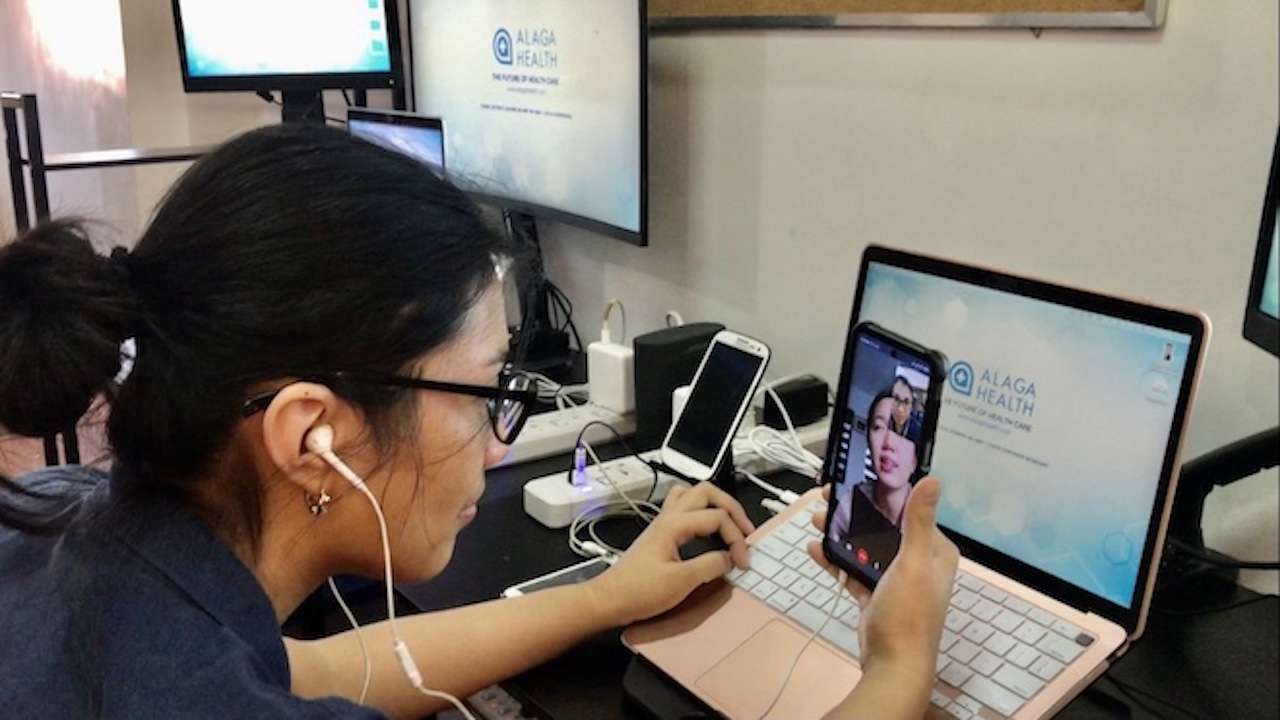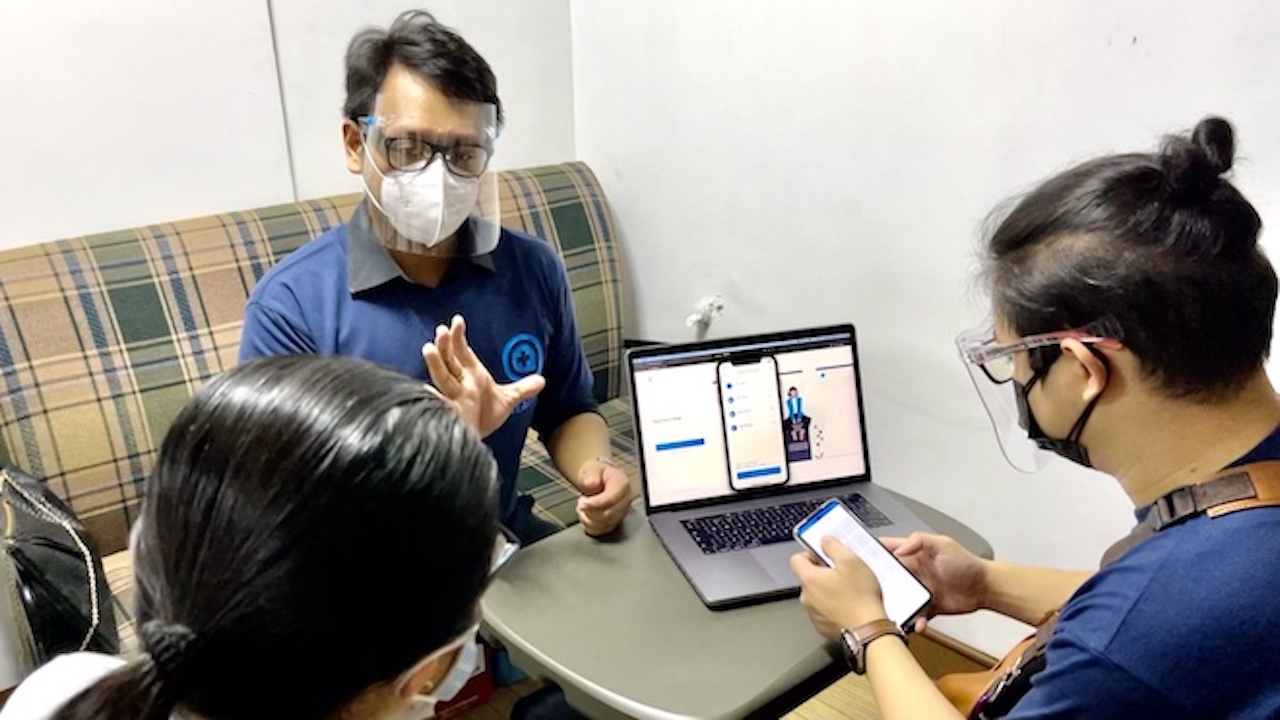
Via Roderos, Alaga Health's chief operating officer, conducts the company's first teleconsultation session. Photo credit: Courtesy of Alaga Health.
Telehealth hopes to offer patients the convenience of consulting with a healthcare service provider without leaving their home or office.
When Dexter Galban was still training as a doctor, he saw an elderly man wait an entire day in hospital just to talk to a health professional for 10 minutes. That experience coupled with his family’s struggle to find nurses who could help take care of his grandmother who was undergoing peritoneal dialysis at home struck a chord with Galban about the gaps in the healthcare system.
“These experiences made me realize that we needed a better way to care for people,” says Galban, chief executive and founder of Philippine-based digital healthcare provider Alaga Health. Alaga is Filipino for care.
Healthcare gaps
According to World Bank data, the Philippines only has 0.6 physicians per 1,000 people. Six out of every 10 Filipinos die because of noncommunicable diseases such as diabetes, cancer, chronic respiratory disease, and cardiovascular disease.
Telehealth or telemedicine hopes to address these gaps by offering patients the convenience of consulting with a healthcare service provider without leaving their home or office.
The Philippine Medical Association, in a guidance about the practice, says telemedicine requires competency in the following areas: digital communication skills, clinical acumen, and knowledge of technology and equipment to be used, while adhering to ethical practice.
The association notes how the coronavirus disease (COVID-19) pandemic transformed the medical practice as the lockdown forced Filipinos to try telemedicine.
A report quoting the head of another telemedicine provider says as of March last year, there were 25 telehealth service providers operating in the Philippines.
Telehealth loaded
Alaga Health’s first telehealth consultation happened in the midst of COVID-19, with a patient who was afraid of getting exposed to the virus if she went to health facilities.
The company started operations in late 2020 although it was conceptualized before the pandemic. Galban started the company with a capital of P100,000. He built the company with Von Payumo, chief experience officer; Bon Dela Cruz, chief technology officer; and Via Roderos, chief operating officer.
Alaga Health does not just offer telemedicine services. It also offers e-health learning and allows patients to book in-person health services such as clinic visits and laboratory tests with partner health providers. Eventually, users can also book home-care services and order medicines and health products from partner stores.
The company also plans a regional foray, leveraging on its partnership with digital health information platform builder Hello Health Group, which has presence across Asia.
Thanks to its wide suite of services, Alaga Health was named runner-up in the Asian Development Bank’s (ADB) Smart Cities Datathon 2021—Building Back Smarter: Digital Solutions for Livable Cities. The company along with the first-place winner bested more than 60 participating teams. Alaga Health received $10,000 in seed money from ADB.
It has also received support from the United Nations Development Programme, PhilDev Foundation, and the Australian Embassy, among others. It also bagged top awards in other hackathons held in the Philippines and abroad, the most recent of which was organized by Philippine telco Globe Telecom.
Since it partners with patient associations, private organizations, and non-government organizations, Alaga Health is in the process of adding one million users to its platform, which is available on the web as well as on Google Play and the App Store.
Galban says the company plans to use part of the seed money from ADB to develop a device that can make the platform available even in geographically isolated and disadvantaged areas with low internet penetration.

Exploring technology’s potential
Before he became a health professional, Galban has always been fascinated by technology, systems, and policies. “I love how they can be used to make life better. In the realm of healthcare, this could mean saving millions at a time.”
In the future, he says technology will eventually serve as an essential component of all forms of healthcare service delivery. “In the same way that we have shifted how we book transportation and get food on-demand, it is likely that healthcare will follow the same track.”
With wearable technology and mobile devices having the capacity to monitor sleeping patterns, heart rates, and physical activity, it may even be possible for health professionals to conduct full physical examinations off-site and diagnose even more health conditions virtually.
“All of these are areas that are currently being explored by Alaga Health,” he says.
The company will also explore using artificial intelligence and big data in serving patients better. This would allow the company to forge strategic partnerships with more clinics, laboratories, and pharmacies to make essential goods and services more easily accessible through its booking and consultation platform. “Technology-enhanced triaging can also help decongest packed hospitals and cut the long lines in health centers.”
Who’s afraid of telehealth providers?
Galban says Alaga Health exists to complement and support healthcare service providers and health facilities.
Through the company’s all-in-one booking, consultation, and payment system, hospitals may even be able to reach more patients who may have difficulty reaching their physical site due to mobility limitations.
The company can also help hospitals implement a schedule and booking management system. “Going beyond telehealth, Alaga Health offers them a suite of services that can help drive down the out-of-pocket costs for patients but increase the revenue of health institutions.”
Asked if Alaga Health doctors ever jump into telehealth calls in their pajamas, Galban says their partner health professionals dress professionally during consultations. “Patients are put more at ease when they see their healthcare service providers well-groomed, properly dressed, and highly prepared for their consultations.”
But on virtual consults, since patients can only see the upper body of the doctors, nurses, and other health professionals, they can still wear their pajamas and bunny slippers—out of sight of the camera. “That's our version of semiformal.”

